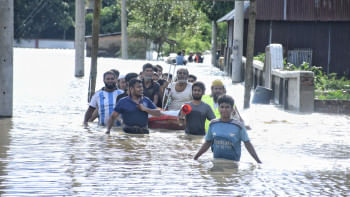What made the flood so severe

In the case of the recent flooding, the precipitation centre that caused it is in Tripura. As a result, the areas surrounding Tripura are experiencing severe floods. Brahmanbaria is situated to the south of Tripura, while Moulvibazar and Habiganj are located to the east.
This situation has led to widespread flooding across these regions. The intense precipitation in Tripura has caused several rivers to overflow. Some rivers have flowed towards the south, some to the north, and others to the southeast, creating an unusual situation.
Rivers in Bangladesh typically flow from the north to the south towards the Bay of Bengal, but that is not always the case. For example, the Gomati River flows from the eastern side of Tripura, through the Dhalai district, passing between two mountain ranges. There is a dam on the first mountain range, where water is collected to produce electricity. Such reservoirs are also used as flood control mechanisms. In the event of heavy precipitation, the dam gates can be opened slowly to release some water, but this has a limit. When the water exceeds this limit, the dam overflows, leading to flooding.
However, the flooding is not solely due to the dam overflow. For instance, the Khowai River originates in Tripura, and there is a barrage at its mouth. There is also a barrage at the origin of the Gomti River. These barrages don't hold much water, so opening or closing them does not directly cause flooding. The flooding is more connected to the opening of gates at the Teesta River, which is connected to the Ganges and the Farakka Barrage. These barrages can hold a significant amount of water, and when they are opened, the heavy flow contributes to flooding downstream.
This time, the flooding was primarily caused by excess rainfall. The army, when mobilised with proper resources and coordination from the state, can play a crucial role in managing such disasters by providing logistical support, such as speed boats and other necessary equipment. However, the current government, being newly in power, may not be fully prepared to take immediate and decisive action. Instead, it is engaging in heavy rhetoric, often adopting an aggressive stance toward India, which is not the right approach.
The situation should be handled diplomatically, with a proper understanding of the hydrological dynamics of the Ganges, Teesta, and other rivers. A well-informed strategy is essential. The government should consider ratifying the United Nations Watercourses Convention of 1997, which has been pending in Bangladesh for a long time. This could be a significant step forward. The interim government's adviser on environment and water resources, Syeda Rizwana Hasan, has suggested taking the river sharing issue onto international platforms, but to do that, Bangladesh first needs to ratify the convention, as going to the UN without accepting the convention will not be effective. Some have alleged that the previous government did not accept the convention due to India's influence, but this government should not adopt the same stance.
As for our roles as ordinary citizens, first, we must refrain from panicking, as difficult as it may be. In situations like this, panicking can often cause further trouble. People who have their own families to look after should treat them as a first priority. Apart from that, individuals whose families are not dependent on them may engage in volunteering in the flood-affected areas, if they have a financial surplus or can collect funds for flood relief.
As for precautionary measures for future disasters, there isn't a lot to be done on an individual level. As flooding is a recurring natural event in Bangladesh, it is often difficult to avoid it completely.
In recent years, the number of young children who cannot swim has gone down significantly compared to the number from a few decades ago. Therefore, parents should take the initiative to teach their children how to swim, which is an essential life skill even without considering the floods. Being more proactive in learning how to swim, as well as teaching others, is something all of us can focus on.
On an institutional level, the Ministry of Disaster Management and Relief, as well as the Ministry of Youth and Sports, should utilise their resources to provide relief and support. The army has already assisted in rescue operations, which should inspire the relevant ministries to use their resources and use self-motivation to help in any way possible.
Even though the interim government is still in its early stages, they should guide the individual efforts by different groups of volunteers in conjecture with utilising the state apparatus. This can ensure that the flood-affected victims are getting the help that they need.
M Inamul Haque is the former director general of River Research Institute.
Views expressed in this article are the author's own.
Follow The Daily Star Opinion on Facebook for the latest opinions, commentaries and analyses by experts and professionals. To contribute your article or letter to The Daily Star Opinion, see our guidelines for submission.

 For all latest news, follow The Daily Star's Google News channel.
For all latest news, follow The Daily Star's Google News channel. 










Comments